Water Resources
Water Resources coordinates the local, state, and federal water resource management programs and projects undertaken in Olmsted County. Our mission is to improve and preserve Olmsted County's water resources.
Visit the tabs below to learn more about various topics and projects.
Greater Zumbro River Watershed Management Plan

In 2018, the Greater Zumbro River watershed was awarded a planning grant by the MN Board of Water and Soil Resources (BWSR) for the One Watershed, One Plan (1W1P) program. The goal of 1W1P is to align local water planning on major watershed boundaries with state strategies towards prioritized, targeted, and measurable action plans.
The planning area for the Greater Zumbro River 1W1P also includes the Mississippi River Lake Pepin (MRLP) Watershed in Goodhue and Wabasha Counties for a combined total drainage area of 1,058,967 acres. The counties and soil and water conservation districts (SWCDs) of Rice, Goodhue, Wabasha, Dodge, and Olmsted, along with the Bear Valley Watershed District and the City of Rochester, entered into a Partnership to develop a watershed plan.
The process was locally lead through a Policy Committee comprised of one elected official from each of the 13 Local Government Units within the watershed. It involved a broad range of stakeholders throughout the process including the use of an Advisory Committee and public meetings. The resulting plan addresses the most significant threats to our water resources and an implementation strategy that provides the greatest benefit to the watershed.
The Watershed Alliance for the Greater Zumbro River Policy Committee released the draft comprehensive watershed management plan for 90-day review in August. The Board of Water & Soil Resources Approved the Plan on October 27th, 2021.
The agenda and meeting information can be found on the Olmsted County Meeting Portal.
The following documents contain various elements such as tables and graphs. For viewing or assistance with interpretation, please reach out to Olmsted County Public Works at 507-328-7070.
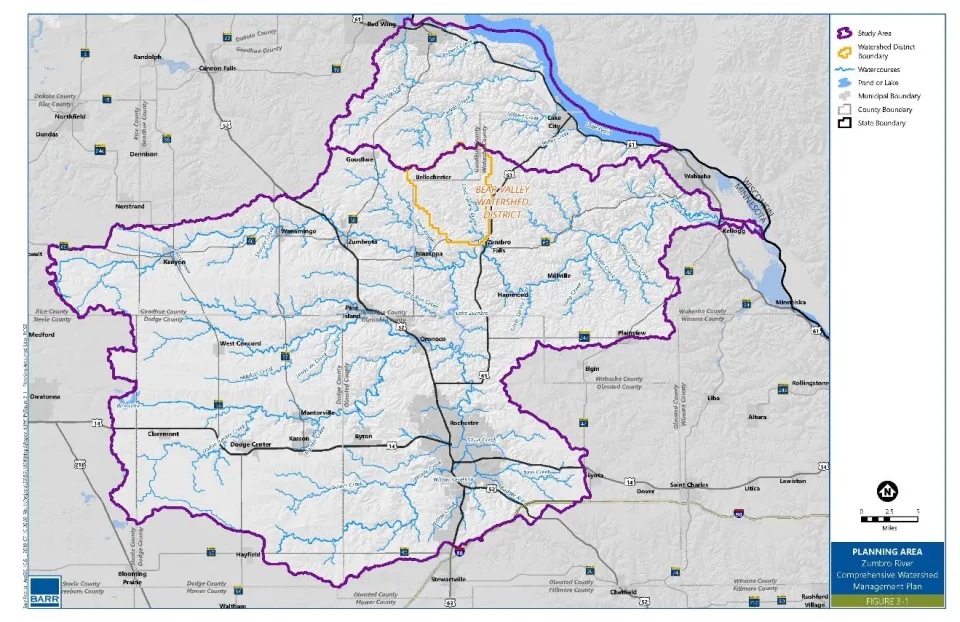
Watershed Alliance for the Greater Zumbro (WAGZ) Policy Advisory Committee
The committee meets four times a year on the second Thursday of the month at 9:00 a.m. at People's Energy Cooperative, 1775 Lake Shady Avenue South in Oronoco, MN. Please see the Olmsted County's Public Meeting Portal for confirmed meeting dates.
Root River Comprehensive Watershed Plan
The Root River Comprehensive Watershed Management Plan was approved by the MN Board of Water and Soil Resources in December 2016. It was adopted by all 13 local government unit partners in the watershed area, including Olmsted County and Olmsted SWCD. The six-county watershed planning area includes those portions of Dodge, Olmsted, Winona, Houston, Fillmore, and Mower counties that drain to the Root River, the MN Portion of the Upper Iowa River Watershed, and the Mississippi-Reno Watershed in Houston County.
The four top priorities in the watershed plan include Drinking water supplies, Rivers and Streams, Landowner Engagement in Water Resource Issues, and Livability.
The Root 1W1P 5-Year Assessment Report can be found here Root River Watershed One Watershed, One Plan (fillmoreswcd.org)
View the map of partner projects that have been completed with Watershed Based Implementation Funding.
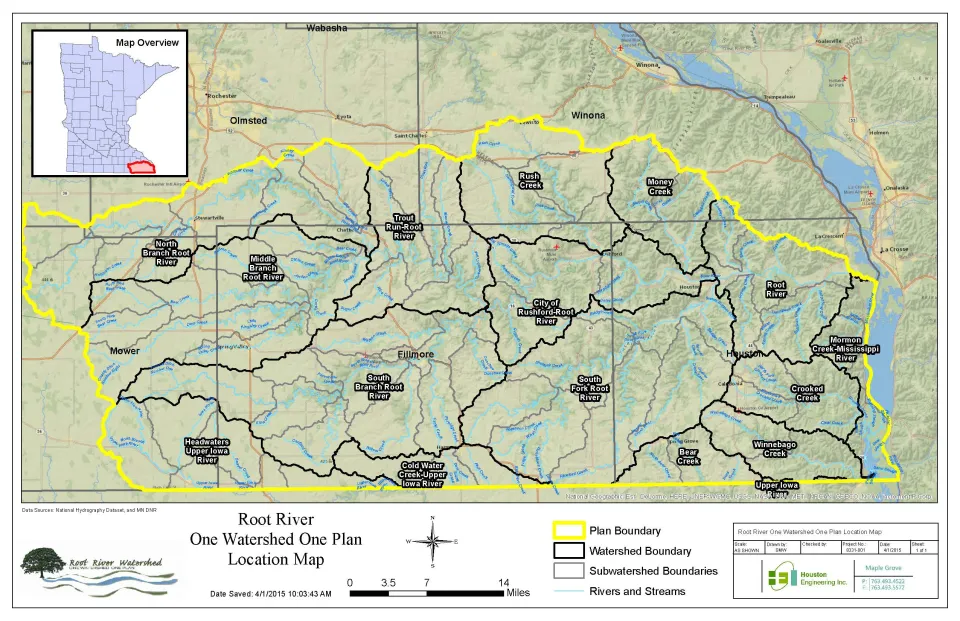
Mississippi River - Winona/La Crescent (WinLaC) One Watershed One Plan (1W1P)
The ten-year Comprehensive Watershed Management Plan for the Mississippi-River Winona – La Crescent Watershed was approved in February 2023. With a completed ten-year plan for the WinlaC, the state of Minnesota will now provide consistent funding to help local partners reach water quality goals. This website will showcase completed projects as the WinLaC Partners collaboratively work to make watershed improvements.
If you live in the WinLaC and need financial or technical assistance to help reduce erosion, protect water resources, or restore habitat on your land, please connect with your local soil and water conservation district. Funding is available in priority areas of the WinLaC Plan.
In 2020, the Mississippi River-Winona/La Crescent (WinLac) watershed was awarded a planning grant by the MN Board of Water and Soil Resources (BWSR) for the One Watershed, One Plan (1W1P) program.
The WinLac planning area includes the Whitewater River Watershed, the largest sub-watershed of the Plan area that falls on the eastern side of Olmsted County. It also includes tributaries that flow directly to the Mississippi River in the Winona and La Crescent areas. The Partnership for this planning effort includes the counties and soil and water conservation districts (SWCDs) of Houston, Olmsted, Wabasha, Winona, along with the Stockton-Rollingstone-Minnesota City Watershed District and the City of Winona.
Links to Final WinLaC Plan and Appendices:
Final-WinLaC-Comprehensive-Watershed-Management-Plan-2023-2033 (winona.mn.us)
Final-WinLaC-Comprehensive-Watershed-Management-Plan-Appendices-2023-2033 (winona.mn.us)

Private Wells and Groundwater
All Olmsted County residents rely on groundwater for their drinking water, While 85% of residents are served by a municipal supply, 15% of Olmsted County residents rely on private wells for their drinking water. It is up to each private well owner to ensure their water is safe to drink.
Olmsted County has a unique geology since it is composed of karst. This bedrock is highly susceptible to cracking and water erosion, thus making groundwater easily polluted by water running off the landscape above. Due to these factors, it is even more important that we preserve groundwater quality.
- Learn more about groundwater and karst in Olmsted County in the story map below.
The Story of Groundwater in Olmsted County

Water quality: Drinking water standards
Public water systems must meet specific water quality benchmarks and are routinely tested to ensure the water source is safe to drink. Private well owners are responsible for the safety of their own drinking water. The National Primary Drinking Water Standards set by the federal government were developed to protect public health by limiting contaminants in the water. While private well owners are not held to those standards, we recommend regular testing and following the safe drinking water standards under “Testing Well Water” so you, your family, and your pets have safe water to drink.
If you would like more information about drinking water contaminants, please see MDH’s A-Z List of Contaminants in Water.
Are you pregnant or have an infant under the age of 1 in the household? Please see Well Water and Your Baby.
Want information on how to test your water quality? Click on the “Testing Well Water” tab below.
Testing well water
Water testing is an inexpensive and effective way to determine the health of your water supply. Contaminated water can often look, smell, and taste fine. It is important to test your well water to make sure that unseen contaminants are absent.
Here are the recommended test frequencies for 5 common contaminants in Minnesota's well water:
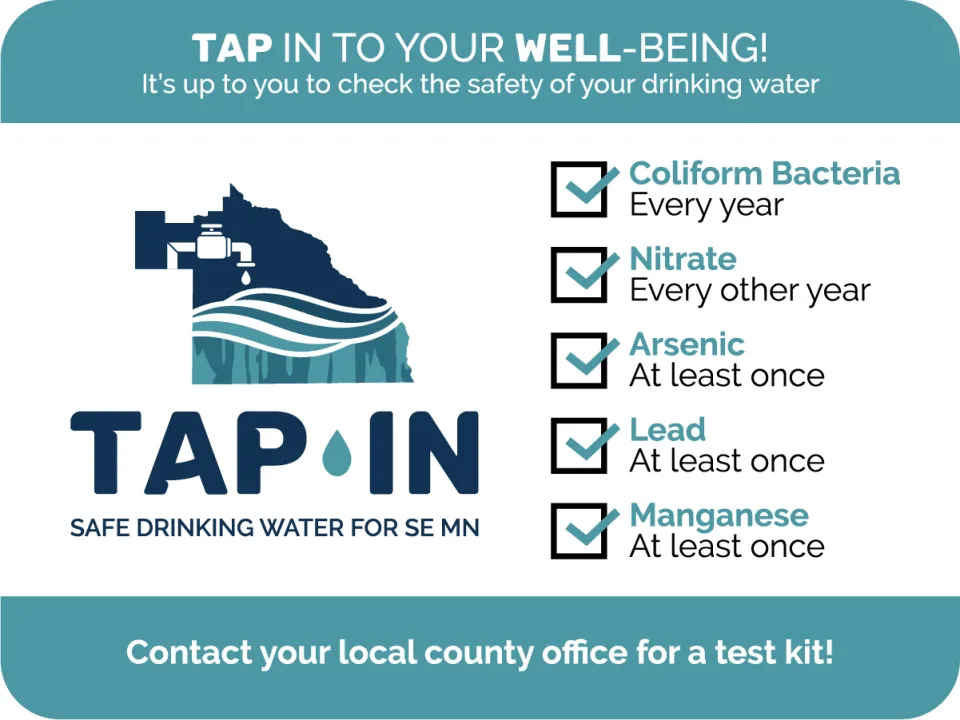
This table from Minnesota Department of Health (MDH) describes health impacts of 5 common contaminants in well water.
If you would like your well water tested, please visit Southeastern Minnesota Water Analysis Laboratory’s (SEMWAL) website. Here, you can find how to request a test kit, sample analysis costs, and instructions for sampling. Alternatively, you can search for other accredited laboratories around the state here.
Olmsted County often provides free nitrate screening and other water testing for residents. Watch for these opportunities on this website and on our Facebook page.
New Hampshire designed a tool that tells you what your water test results mean. You can enter your water test results anonymously and receive advice on treatment options online. Try it out here.
Well maintenance and repair
Most well maintenance is preventative, and generally involves awareness of your well and its positioning on the landscape. There are a few basic tips to keep in mind:
- Keep a good distance between your well and structures such as buildings, waste systems, or chemical storage facilities
- Ensure the top of your well is at least 1 foot above the soil surface, and slope the soil away from the casing to prevent flooding
- Be careful when working around your well, especially with lawn mowers or other machinery
- Keep chemicals such as paint, fertilizer, pesticides, and oil away from your well
- Avoid submersing or putting your hose in direct contact with containers with chemicals or other hazardous material, and do not leave your hose lying on the basement floor. This will ensure contaminants do not flow backwards through your hose into your water reservoir (this is referred to as back-siphonage).
If your well is damaged or has defective parts, seek help from a licensed well contractor or pump installer.
Well disinfection: Your well should be disinfected:
- If it was just drilled
- Before the water is used for drinking or cooking for the first time
- Whenever it is opened for repair
- When it is flooded
- If you suspect a septic system failure has contaminated your well
Resources for well disinfection:
Abandoned well:
Abandoned wells are a direct line for contaminants to make their way into groundwater. For this reason, it is very important to properly seal wells that are no longer in use. Only a licensed well contractor or licensed well sealing contractor may seal a well and must do so in accordance with Minnesota law.
If you are interested in more instructions for well maintenance or possible treatment systems, please see the Minnesota Department of Health’s Well Owner Handbook. Otherwise, seek expert advice from a licensed well specialist.
Financial assistance is available for both well sealing and well repair. Please see the “Available Financial Assistance” tab below for more information.
Links to additional resources: Owner's Guide to Wells
Well permits
New well construction is regulated by the well and septic division of Olmsted County, under the Water Well and Water Supply Ordinance. To construct a new well, Olmsted County requires that landowners apply for a permit. This ensures that safe building practices will be followed. The application, permit fees, and other materials required to obtain a permit can be found on Olmsted County’s Building, Well and Septic Permit page.
Well sealing
- Abandoned wells are a direct line for contaminants to make their way into groundwater. For this reason, it is very important to properly seal wells that are no longer in use. Only a licensed well contractor or licensed well sealing contractor may seal a well and must do so in accordance with Minnesota law.
- For more information on the sealing process, see the Well Owner’s Handbook - A Consumer's Guide to Water Wells in Minnesota.
- If you would like to drill a new water well or seal an abandoned well, please see the list of Licensed/Registered Water Well Contractors in Minnesota.
- Financial assistance programs are available for well sealing. Please see the “Available Financial Assistance” tab below for more information.
Property transaction requirement
- If you sell your property, Minnesota law requires you disclose the location and status of wells on the property. For more information, please see the Well Owner’s Handbook - A Consumer's Guide to Water Wells in Minnesota.
- Sometimes, a water quality test may be required before the property is sold. Ask your realtor or mortgage lender if this will be necessary. For more information on water testing, please see the “Testing Well Water” tab above.
Find well construction information
- To find information about your well, visit the Minnesota Well Index.
Groundwater studies and resources
The Olmsted County Geologic Atlas - Part A illustrates Olmsted’s geology and provides further links to the Minnesota County Atlas Series.
The following are programs and projects aimed at monitoring and assessing the quality of groundwater in Olmsted County.
- Olmsted County’s Long-Term Groundwater Monitoring Network
- A long-term groundwater monitoring network was established in 1991 to assess water quality in the vicinity of the Decorah Edge in six townships in the western and central part of Olmsted County. Wells were sampled in 1991, 2001, 2011, 2014, 2015, and 2021. The network data is routinely used in aquifer management planning and assessments. Below is a figure showing the 2021 sampling locations (represented as black dots) and underlying geologic formations.
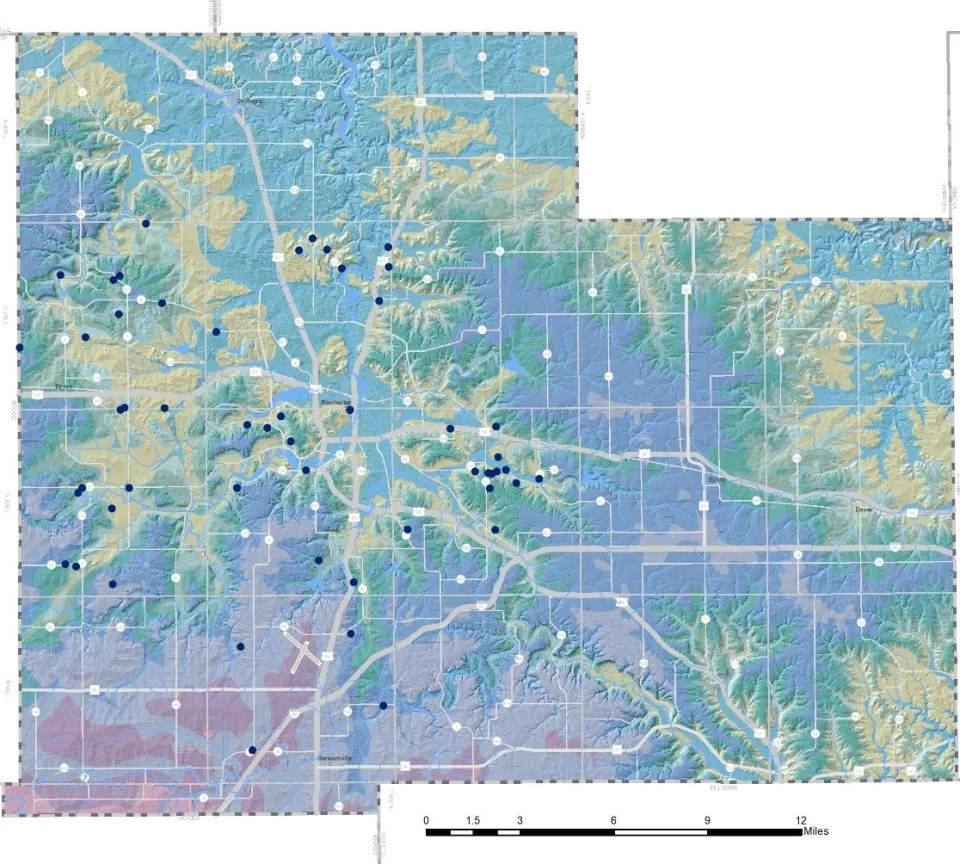
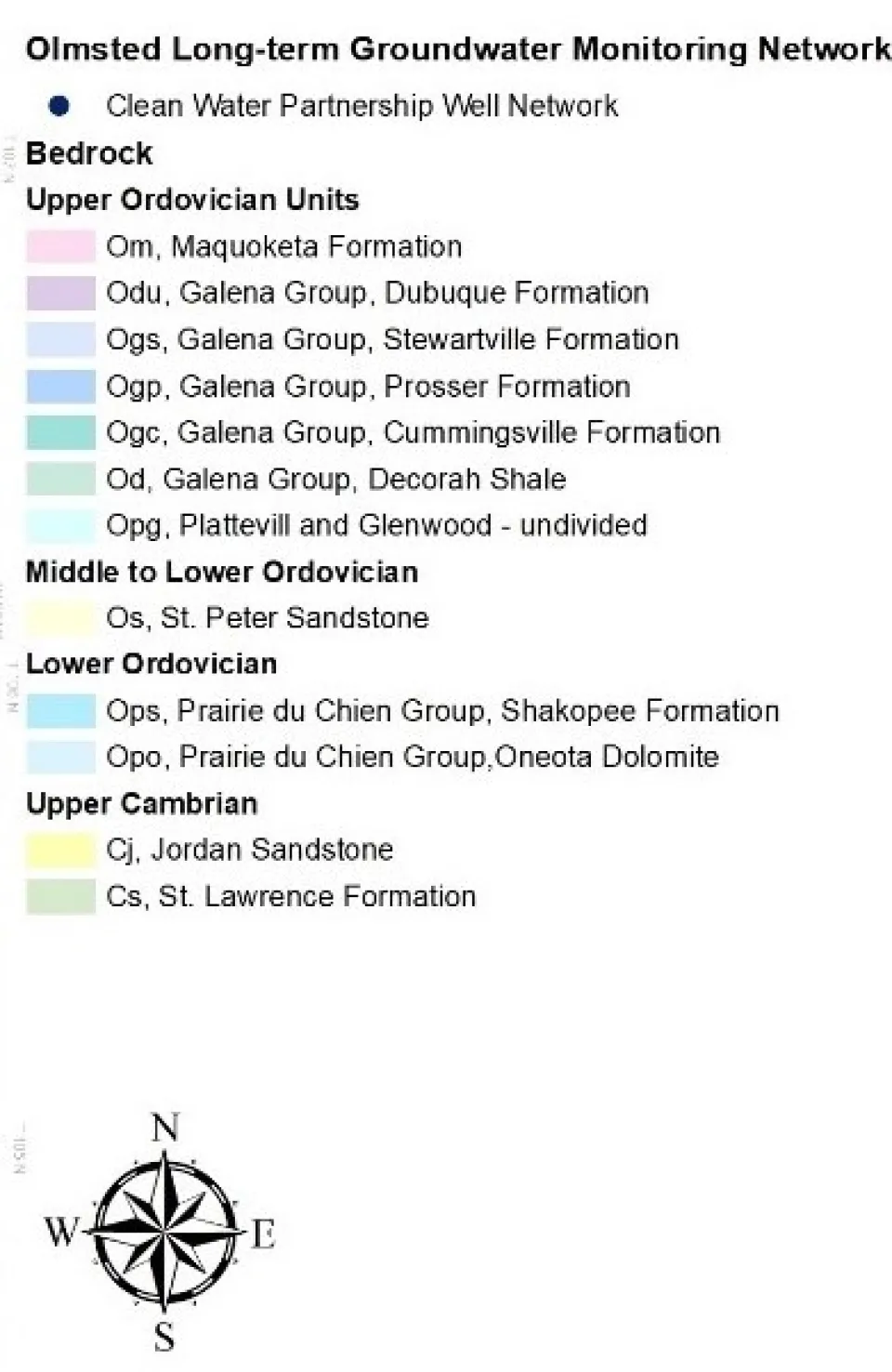
- Volunteer Nitrate Monitoring Network
- Olmsted County coordinates a 9-county wide nitrate monitoring program, called the Volunteer Nitrate Monitoring Network. Domestic well owners (volunteers) are sent a nitrate test kit directly to their home on an annual basis by the Southeastern Minnesota Water Analysis Lab (SEMWAL). The homeowner simply fills up the bottle and sends it directly back to SEMWAL for analysis. After analysis is complete, homeowners receive their water test results via mail. All results are compiled and graphed (see the graph for 2020 results below) to see how nitrate concentrations vary across the 9 county regions
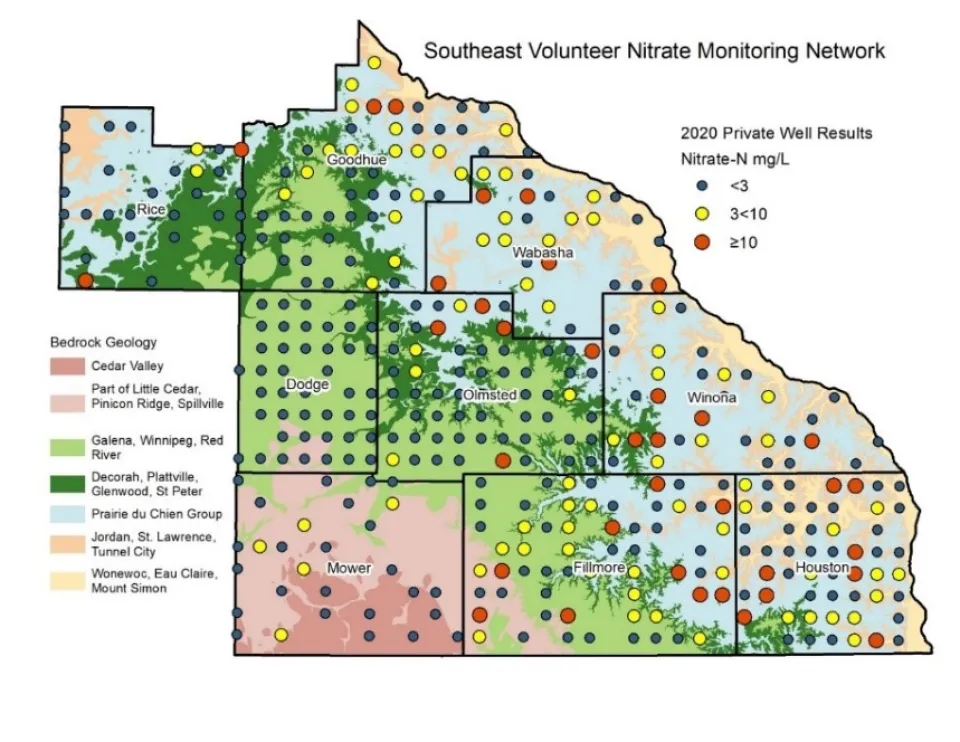
In 2014 and 2015, a targeted subset of the regional Volunteer Nitrate Monitoring Network, called the Southeast Minnesota Domestic Well Network, was tested for a more complete set of parameters. The Division collected field measurements and samples at each of the wells under a contract with the SE MN Water Resources Board. This data helped to further characterize understanding of water contaminant presence in relation to bedrock geology.
- Minnesota Department of Agriculture (MDA) Township Testing
- This program provided free nitrate testing to homeowners with private wells in 2014. If nitrate was detected in the sample, they were offered a subsequent pesticide test. In Olmsted County specifically, 11 vulnerable townships were selected and 1057 wells were tested.
- This figure from MDA’s report provides an overview of the percentage of wells in each township that were over the Health Risk Limit (HRL) of 10 mg/L of nitrate-nitrogen (Nitrate-N).
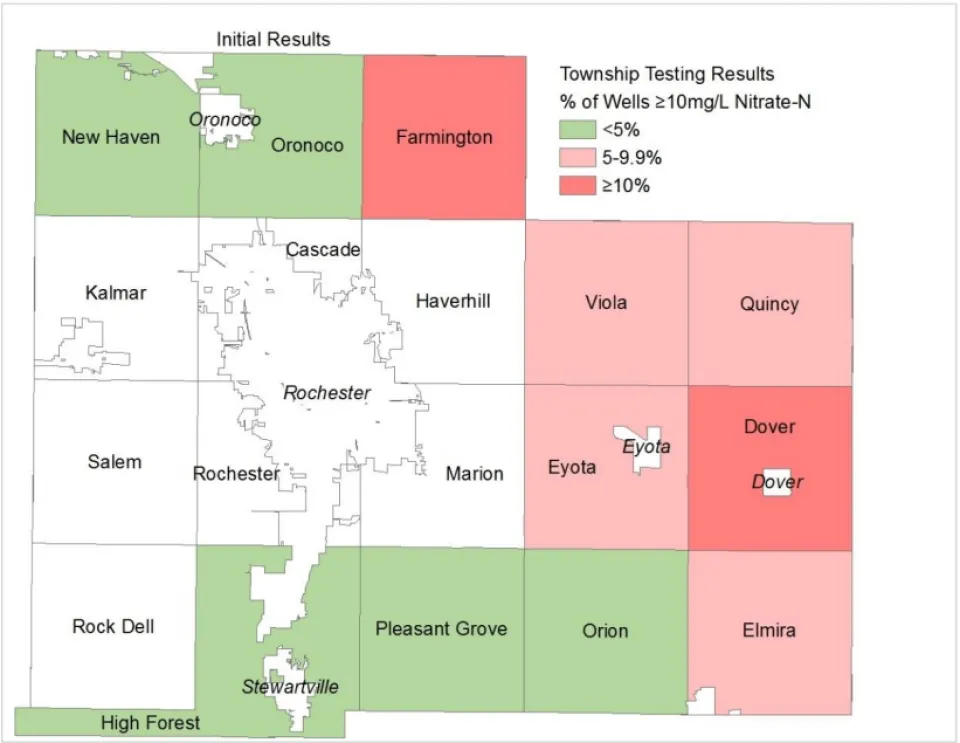
Credit for image: Olmsted County: Final Overview of Nitrate Levels in Private Wells (2016-2017)
You can view the summarized report for Olmsted County’s Township Testing here. A full report with more background on the subject can be found here.
- Hydrochemical Survey of Groundwater Flow in the Rochester Metropolitan Area
- Robert Tipping, a researcher from University of Minnesota Twin Cities, compiled a review of water chemistry data in the Rochester Metropolitan Area. This report includes data obtained from Olmsted County’s Longterm Groundwater Monitoring Network. Tipping provides detailed descriptions of Rochester’s geology and illustrates how this affects water chemistry in the surrounding areas.
Well Abandonment and Sealing Financial Assistance
- Agricultural Best Management Practice Loan Program
- Olmsted County Soil & Water Conservation District | 507-328-7070 | swcd@olmstedcounty.gov
- Contact your local municipality. Funding may be available to help seal wells within city limits or drinking water supply management areas.
Septic System (SSTS) Loans/Funding Sources
- There are five funding sources available to homeowners within Olmsted County, that may assist with the cost of septic system replacement. Visit the well and septic page for a list of the sources and additional information.
Tap In - Safe Drinking Water for SE MN
Testing & Financial Assistance
Regular monitoring of drinking water and understanding how the quality of water is changing allows us to identify, prevent, and address contamination before it reaches a level that can negatively impact health. To make sure your water is safe for you and your family, remember to TAP IN!
TAP IN stands for:
Test your water
Ask a professional
Protect your water quality
Inspect your well and septic system
Note important information.
Visit our TAP-IN landing page https://bit.ly/TAPINMN to find water testing and funding resources for mitigating contaminants in your private well.
Please contact the Olmsted Soil and Water Conservation District (SWCD) for more information about financial assistance available to private well owners at 507-328-7070 or swcd@olmstedcounty.gov.
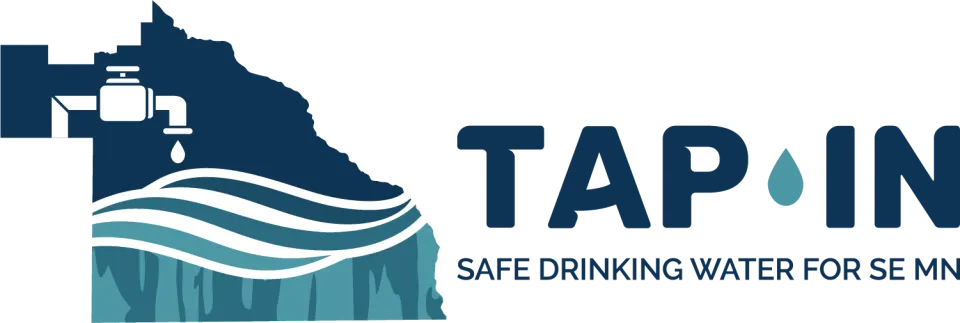
Programs and projects
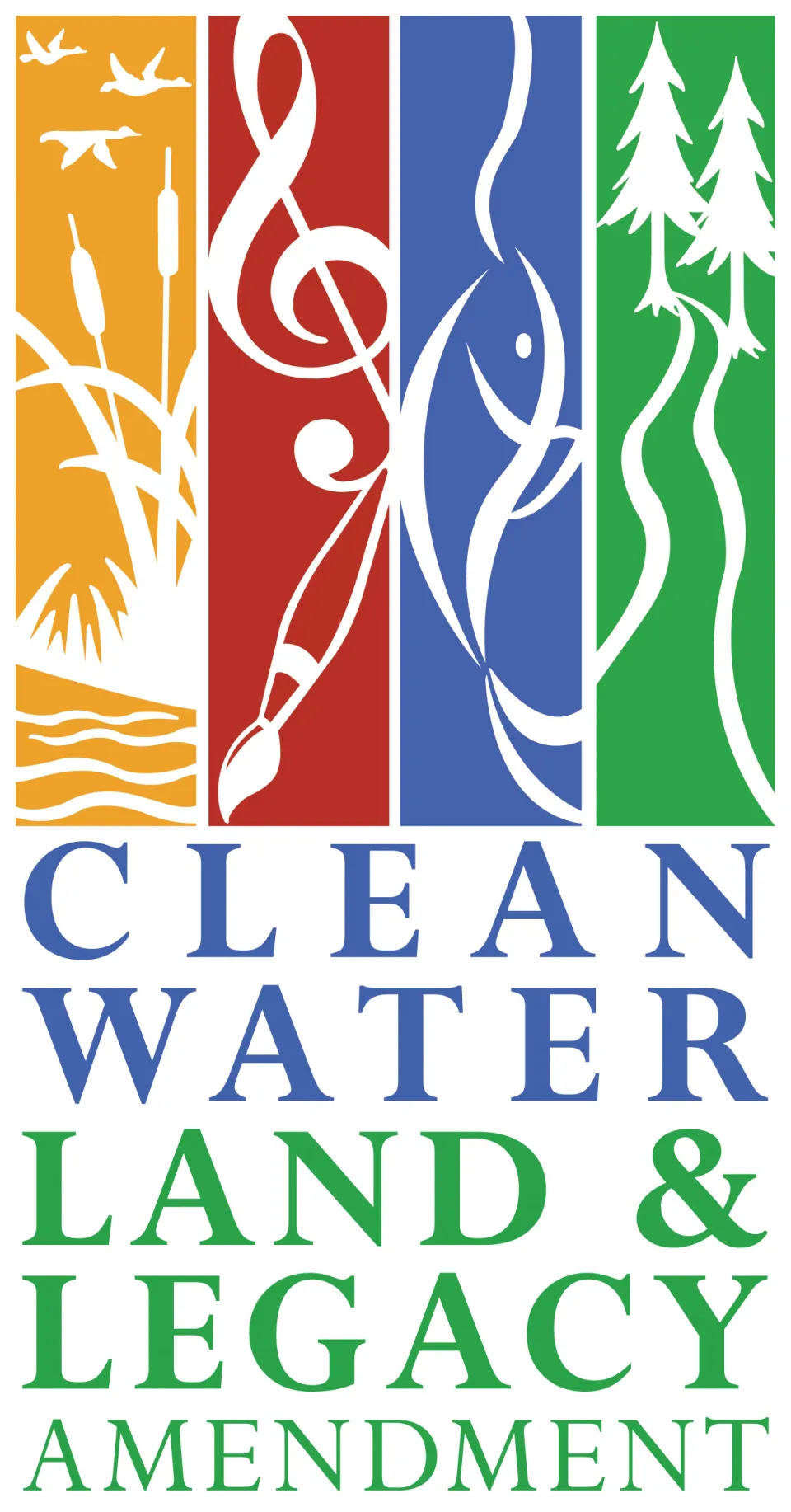
Well Sealing and Aquifer Characterization Below the Jordan Aquifer in the Rochester Metropolitan Area
Protecting groundwater aquifers in Olmsted County is critical as the community continues to experience high growth. Currently, there are no municipal supply wells solely in the aquifers beneath the Jordan in Olmsted County. Olmsted County is partnering with Rochester Public Utilities (RPU) on this project to research sustainable future use of aquifers below the Jordan aquifer in the greater Rochester area. Grant funds will be utilized to seal an inactive municipal well in Rochester that interconnects many aquifers below the Jordan aquifer. RPU can further leverage the sealing of the well to install a multi-well nest to obtain data on the deeper aquifers. The multi-well nest will be used to obtain data on the deep aquifers to assess flow, quantities, and vulnerabilities to contamination. Funding through the Board of Water and Soil Resources, Clean Water Fund, has been dedicated to seal the well. Funding from other sources is available to install the well nest and conduct monitoring.
Oronoco Dam Removal and Zumbro River Restoration Project
Construction Dates: 2017 - July 2018
Background
Lake Shady was a reservoir on the Zumbro River created in 1937 by a dam constructed by the federal Works Progress Administration. By the late 1970s, sedimentation had largely ended recreational use of the lake. In July of 1989, the Lake Shady Restoration and Preservation Committee was established to work with federal, state, and local governmental agencies in an effort to restore the Lake.
2010 Flood
Much of Southern Minnesota received extensive rain in late September 2010. This major storm system caused severe flooding throughout many communities in the area. With eventual rainfall totals surpassing seven inches in the Zumbro Watershed, the river swelled to historic levels. By noon on September 23, 2010, floodwaters had washed away the north embankment of the Oronoco Dam and had heavily damaged the bridge on Minnesota Avenue.
Restoration Project
The Zumbro River Restoration Project received $4.1 million in funding from the State of Minnesota, Olmsted County, and the City of Oronoco. Construction began in November 2016 and ultimately transformed the lakebed into a public space that provides a variety of recreational opportunities. The dam was replaced by a rock arch rapids, the stream restored to natural meanders, and excess sediment was placed out of the floodway so it could not be washed downstream.
South Zumbro Stormwater and Capital Improvement Plan
Chester Heights Sewer District
The Chester Sewer District serves all properties in the Chester Heights Subdivision, the Village of Chester, and Menard’s Subdivision. Sewage is pumped to the City of Rochester and treated at the Rochester Water Reclamation Plant. Olmsted County Public Works, Water Resources Division, oversees the administration of the Sewer District and contracts with Gopher Septic Services for its operation and maintenance.
Sewer fees
Are set annually and are based on service costs.
Will be billed annually as a special assessment on the property tax statement on line #13.
New properties connecting to this sewer district are charged a one-time fee.
2025 service rates
Residential - $74.71/month
Apartments
2 Residential units - $111.71/month
4 Residential units - $182.81/month
Small commercial - $113.27 (less than 5,000 gals/month)
Large commercial - $113.27 (more than 5,000 gals/month plus $5.74 per additional 1,000 gals)
Buildable lots with sewer stubbed in but no existing dwelling - $34.87/month
Disposable wipes clog pipes - Do not flush!
If you are a Chester resident, please don't flush disposable wipes as they can cause sewer backups and additional maintenance costs.

Chester Heights Sewer District Advisory Board
The advisory board counsels the Olmsted County Board of Commissioners on operational and financial matters concerning the sewer district.
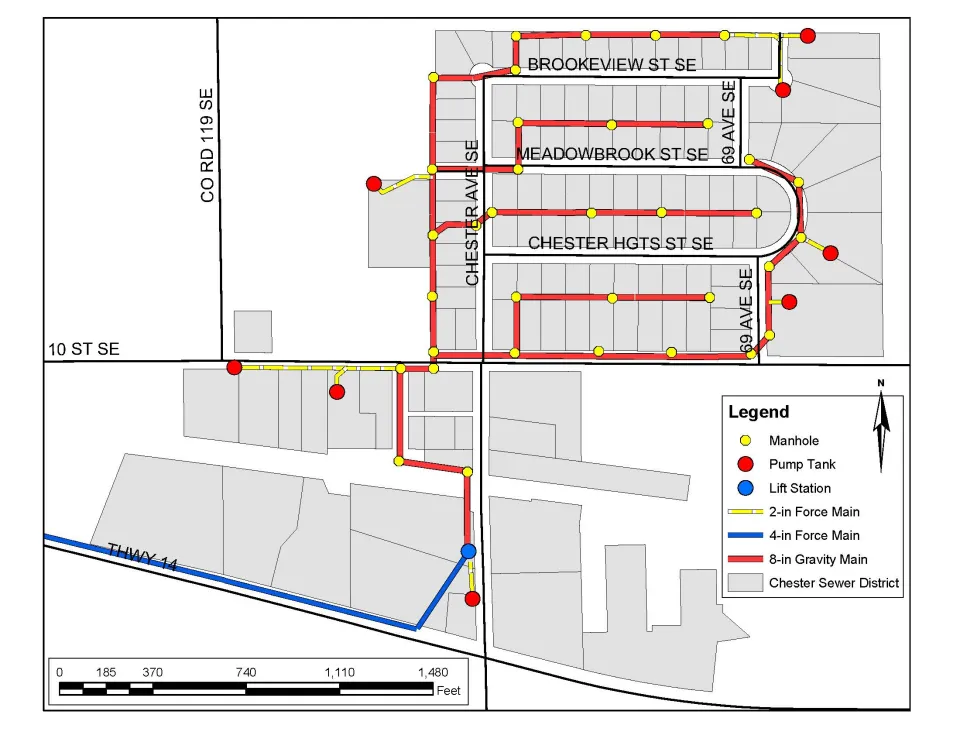
For information on requesting a hearing to appeal a notice of violation, or denial of a request for exception/challenge, or a suspension or revocation of an issued license or permit, please visit the Olmsted County Attorney's webpage.
To report a problem with service or an emergency, please contact:
Gopher Septic Services
507-282-2243
Water reports
Minnesota BWSR Clean Water Fund Stories
If interested in a particular Water Report from Olmsted County please contact the Water Resources Coordinator at 507 328-7070

